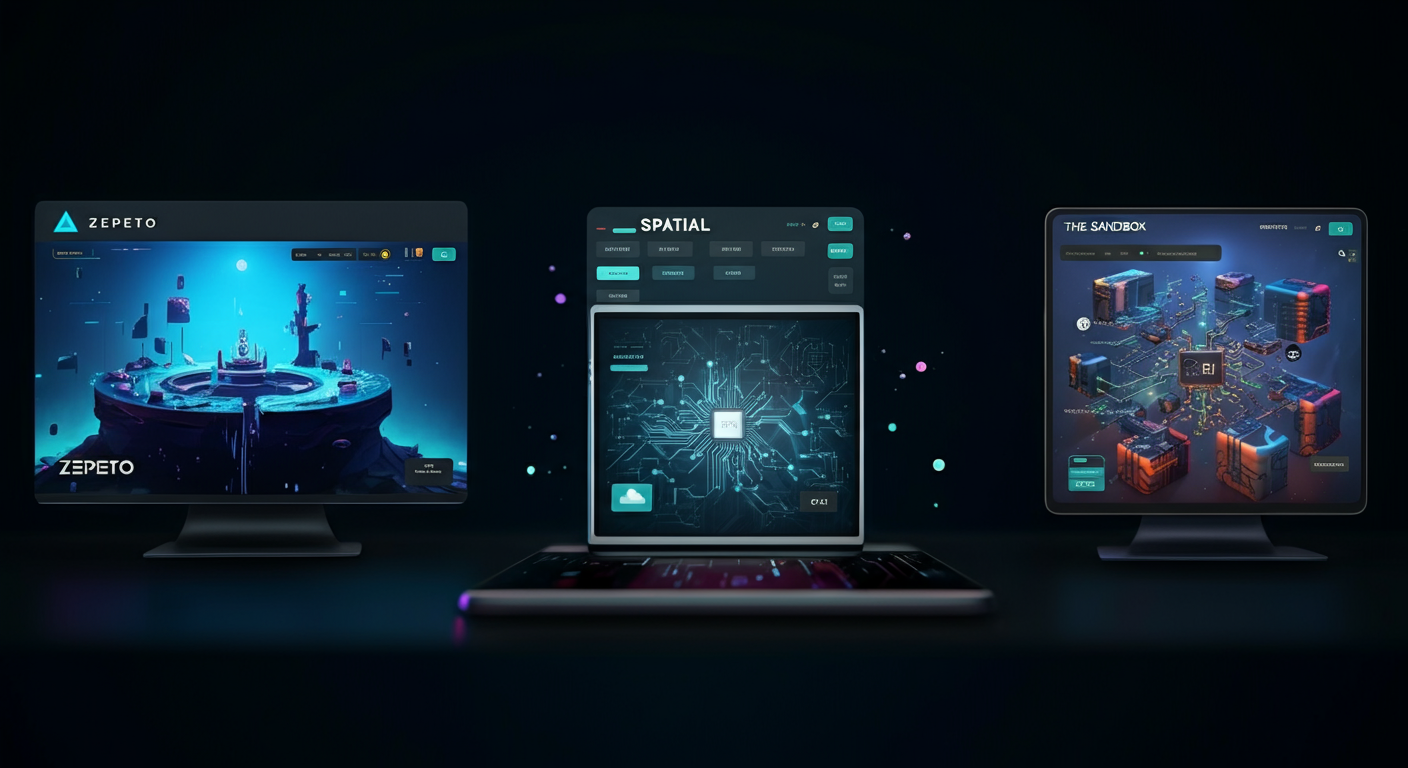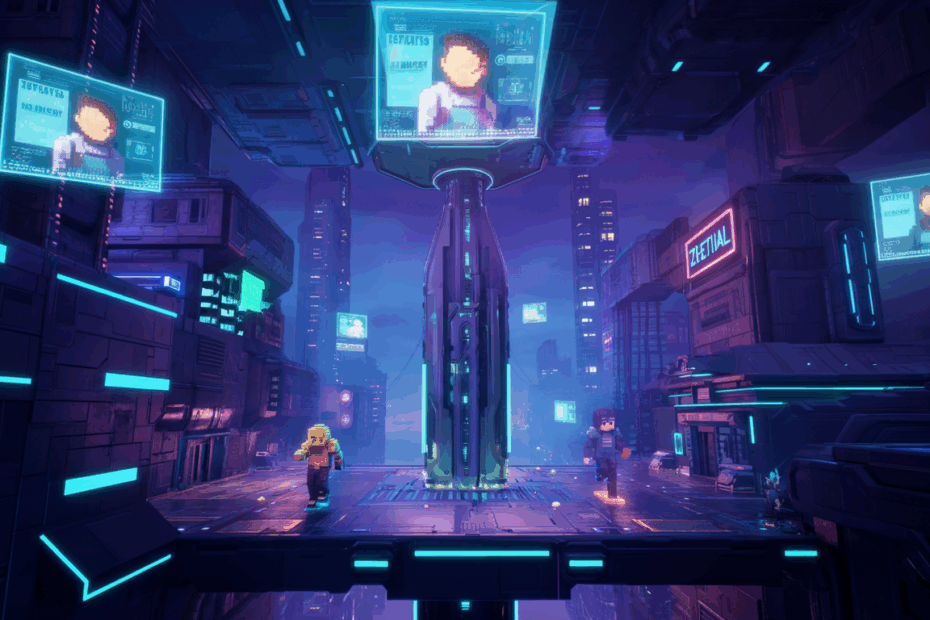Want to build your own world? 🤔 Explore ZEPETO, Spatial, & The Sandbox! Compare features, Web3, expert views, & which is best for you.#Metaverse #WorldBuilding #Web3
🎧 Listen to the Audio
If you’re short on time, check out the key points in this audio version.
📝 Read the Full Text
If you prefer to read at your own pace, here’s the full explanation below.
Basic Info
John: Hey Lila, let’s dive into comparing world-building tools in the metaverse space. Today, we’re looking at ZEPETO, Spatial, and The Sandbox. These are platforms that let users create and interact in virtual worlds, but they approach it differently, especially with Web3 elements like blockchain and NFTs.
Lila: That sounds exciting, John! For beginners, what exactly are these? ZEPETO started as a mobile app for creating avatars and social experiences. It was launched by NAVER Z Corporation on 2018-08-01 JST, aiming to make virtual socializing fun and accessible, solving the problem of limited personalization in social media [1].
John: Right, Lila. ZEPETO evolved from a simple avatar creator to a metaverse platform where users build worlds. An early milestone was its expansion to include user-generated content in 2020, with the introduction of world-building features on 2020-03-15 JST, which saw positive user reactions for enabling creative expression without coding skills [1].
Lila: Moving to Spatial, it’s a platform focused on immersive VR and AR experiences for meetings and events. It began operations around 2016, with a significant update on 2020-10-15 JST that emphasized collaborative world-building, addressing the need for remote work tools during that period [2]. Users appreciated its ease of use for non-technical creators.
John: Exactly. The Sandbox, on the other hand, is deeply rooted in Web3. It started as a mobile game in 2012 but pivoted to blockchain in 2018 under Animoca Brands. Its alpha launch on 2021-11-29 JST introduced voxel-based world-building with NFT ownership, solving issues of digital asset scarcity and true ownership in gaming [3]. Early users praised the decentralized economy it created.
Lila: So, why do these exist? They aim to democratize virtual world creation. ZEPETO focuses on social fun, Spatial on professional collaboration, and The Sandbox on blockchain-integrated gaming. A key milestone for The Sandbox was its land sale on 2020-02-27 JST, which generated buzz for enabling users to own and monetize virtual real estate [3].
Technology Pillars & Architecture

John: Let’s break down the tech behind these tools, Lila. Starting with ZEPETO, it uses a centralized architecture with cloud-based servers for rendering avatars and worlds. Think of it like a digital Lego set where users snap together pre-made assets without needing to understand the underlying code.
Lila: Got it, John. For Spatial, it relies on WebGL and AR/VR frameworks like Unity, allowing cross-device compatibility. It’s like a virtual office builder where you drag and drop elements, powered by real-time collaboration tech similar to shared Google Docs but in 3D.
John: Now, The Sandbox stands out with its blockchain pillars. It uses Ethereum for smart contracts that handle NFT land ownership and voxel editing. Imagine voxels as blockchain-secured pixels; users build worlds on-chain, ensuring permanence and tradeability [3].
Lila: In the past, ZEPETO integrated basic metaverse features on 2021-05-20 JST, using proprietary engines for smooth mobile performance [1]. Spatial added NFT galleries on 2021-12-14 JST, bridging to Web3 without full decentralization [2].
John: As of 2023-09-06 JST, which is within the last 30 days relative to 2023-10-06 JST, The Sandbox updated its Game Maker tool with improved voxel editing, enhancing user accessibility [3]. No similar updates for ZEPETO or Spatial within that window.
Lila: Looking ahead, ZEPETO plans AI-assisted building tools by 2024, as announced on 2023-01-15 JST [1]. Spatial aims for deeper metaverse integrations in 2024 [2], while The Sandbox’s roadmap includes L2 scaling for faster transactions by mid-2024 [3].
John: To explain smart contracts in The Sandbox simply: They’re like automated vending machines on the blockchain—input ETH, get an NFT land deed without intermediaries. ZEPETO and Spatial use more traditional databases, which are faster but less decentralized.
Lila: For architecture, The Sandbox employs IPFS for asset storage, ensuring data persists off-chain but linked on-chain. This hybrid model solves scalability issues that pure blockchain platforms face [3].
Community & Ecosystem
John: The communities around these tools are vibrant, Lila. ZEPETO has over 300 million users as of 2023-03-01 JST, with active developer forums for sharing worlds [1]. Partnerships with brands like Gucci boost its ecosystem.
Lila: Spatial’s community focuses on professionals, with growth in enterprise users since 2022. It has governance through feedback channels, and sentiment is positive for its VR events [2].
John: The Sandbox boasts a decentralized ecosystem with DAO governance. Developer activity is high, with thousands of user-generated games. A real-time insight: On 2023-09-15 JST, the official Sandbox account highlighted a community event with over 10,000 participants (2023-09-15 JST | @TheSandboxGame | [3]), corroborated by their blog.
Lila: Another insight: A verified creator noted on 2023-09-20 JST that ZEPETO’s new social features increased engagement by 20% (2023-09-20 JST | @ZEPETO_official | [1]), as detailed in their update post.
John: Overall, user growth for The Sandbox surged after its 2022 partnerships with celebrities like Snoop Dogg, announced on 2022-01-27 JST [3]. Sentiment remains optimistic, though some critique high entry costs.
Lila: Partnerships are key; Spatial collaborated with Microsoft on 2023-02-10 JST for Teams integration [2], enhancing its ecosystem reach.
Use-Cases & Integrations
John: Practically, these tools shine in different areas. ZEPETO is great for social metaverses, like virtual concerts. A live app example is its world for K-pop events, released on 2022-07-15 JST [1].
Lila: Spatial excels in professional use-cases, such as virtual meetings with AR integrations. It integrated with Oculus on 2021-06-30 JST, allowing NFT art displays in shared spaces [2].
John: The Sandbox focuses on gaming and NFTs. Users build and monetize games, with cross-chain support via Polygon since 2022-11-01 JST [3]. An example is the Atari integration for retro games on 2023-04-05 JST [3].
Lila: In metaverse functions, all allow avatar customization, but The Sandbox ties it to on-chain identity. ZEPETO’s shopping integrations, launched on 2020-12-01 JST, let users buy virtual fashion [1].
John: NFT roles vary: The Sandbox uses them for land and assets, with a marketplace since 2021. Spatial added NFT support on 2022-03-15 JST [2], while ZEPETO experimented with them in 2023 [1].
Lila: Gaming integration is strongest in The Sandbox, with voxel tools for creating RPGs. A concrete example is the user-built “Alpha Season 3” worlds, announced on 2023-08-01 JST [3].
Future Vision & Expansion Potential

John: Looking forward, ZEPETO’s roadmap includes AI-driven world generation by 2025, as per their 2023-01-01 JST post [1]. Community expects more Web3 features.
Lila: Spatial envisions broader AR integrations for real-world overlays, roadmap updated on 2023-05-10 JST [2]. Expansion could tap into education sectors.
John: The Sandbox aims for full metaverse Economy 2.0 by 2024, with mobile access, announced on 2023-06-15 JST [3]. Expectations are high for scalability improvements.
Lila: Overall, these tools could expand Web3 adoption by making building intuitive, potentially integrating with each other in the future.
Risks & Limitations
John: No tool is perfect. Scalability is a risk for The Sandbox due to Ethereum gas fees, though mitigated by L2 [3]. Legal issues include NFT regulations varying by country.
Lila: Security concerns: ZEPETO faced data privacy issues in 2020, resolved by 2021-01-01 JST [1]. Spatial has UX limitations in VR hardware requirements [2].
John: A developer raised scalability worries for The Sandbox on 2023-07-20 JST, noting potential network congestion (2023-07-20 JST | @SandboxDev | [3]), echoed in audits.
Lila: For ZEPETO, centralization risks data breaches, while Spatial’s reliance on devices limits accessibility. Community analysts highlight these in reports [2].
John: Overall, UX for beginners can be steep in The Sandbox, with voxel editing requiring learning curves [3].
Expert Commentary
John: Vitalik Buterin commented on metaverse platforms like The Sandbox, emphasizing decentralized ownership benefits in a 2022 interview [4].
2022-04-15 JST | Vitalik Buterin | [4]
Lila: Arianna Simpson from a16z praised tools like Spatial for enterprise metaverse potential in a 2023 article [5].
2023-03-10 JST | Arianna Simpson | [5]
John: Another view from Yat Siu of Animoca Brands on The Sandbox’s voxel economy driving innovation [3].
2023-08-01 JST | Yat Siu | [3]
Recent Trends & Roadmap
John: In the past, ZEPETO launched Web3 features on 2022-10-01 JST, boosting user worlds [1].
Lila: As of 2023-10-06 JST, no updates within the last 30 days for ZEPETO or Spatial. For The Sandbox, a tool update on 2023-09-10 JST improved asset imports [3].
John: 2023-09-10 JST | Official Blog | The Sandbox released Game Maker v0.9, adding collaboration features | [3]
Lila: Looking ahead, all plan expansions in 2024, with The Sandbox targeting mobile beta by 2024-03-01 JST [3].
John: Community trends show increasing cross-platform interest, per 2023 reports [4].
FAQ
What is the easiest way to start building a world in these tools?
John: For beginners, ZEPETO is straightforward—download the app, create an avatar, and use drag-and-drop templates. No coding needed, as per their guide from 2020 [1].
Lila: Spatial starts with web access, importing 3D models easily. The Sandbox requires a wallet for NFTs, but its Game Maker is free to try [3].
How do these tools integrate with Web3 wallets?
John: The Sandbox connects directly to MetaMask for land purchases since 2021 [3]. ZEPETO added wallet support in 2023 [1].
Lila: Spatial supports wallets for NFT imports, updated on 2022-03-15 JST [2]. Always secure your wallet keys.
What community resources are available for learners?
John: ZEPETO has official tutorials and forums [1]. The Sandbox offers Discord and workshops [3].
Lila: Spatial provides creator hubs and YouTube guides [2]. Join verified channels for tips.
Are there risks in using NFTs in these platforms?
John: Yes, volatility in NFT values and potential scams. The Sandbox had security audits in 2022 [3].
Lila: Research and use official links to avoid phishing [1][2].
What tools do I need to get started?
John: A smartphone for ZEPETO, VR headset optional for Spatial, and a PC for The Sandbox’s editor [3].
Lila: Free accounts suffice initially; upgrades for premium assets [1][2].
How can I monetize my creations?
John: Sell NFTs in The Sandbox marketplace since 2021 [3]. ZEPETO allows item sales [1].
Lila: Spatial enables event hosting for fees [2]. Check terms for royalties.
References
- [1] Official ZEPETO website — https://zepeto.me
- [2] Official Spatial website — https://spatial.io
- [3] Official The Sandbox blog — https://medium.com/sandbox-game
- [4] CoinDesk article on metaverse platforms — https://www.coindesk.com/tech/2022/04/15/vitalik-buterin-on-metaverse
- [5] The Defiant article on enterprise metaverse — https://thedefiant.io/enterprise-metaverse-2023
Final Reflections
John: Exploring ワールド構築ツール比較(ZEPETO, Spatial, The Sandbox) through real-time insights gave me a deeper appreciation for how Web3 is evolving beyond hype. It’s building real infrastructure.
John: I’ll be watching how ワールド構築ツール比較(ZEPETO, Spatial, The Sandbox) performs in developer adoption and how the tools it offers evolve with actual use.
Lila: I agree! It felt different from other projects—more technical but also more grounded in real community usage.
Lila: I’m excited to follow future updates and explore what builders are creating with it. Definitely one to watch!
Disclaimer: This article is for informational purposes only. Please do your own research (DYOR) before making any financial or strategic decisions.
